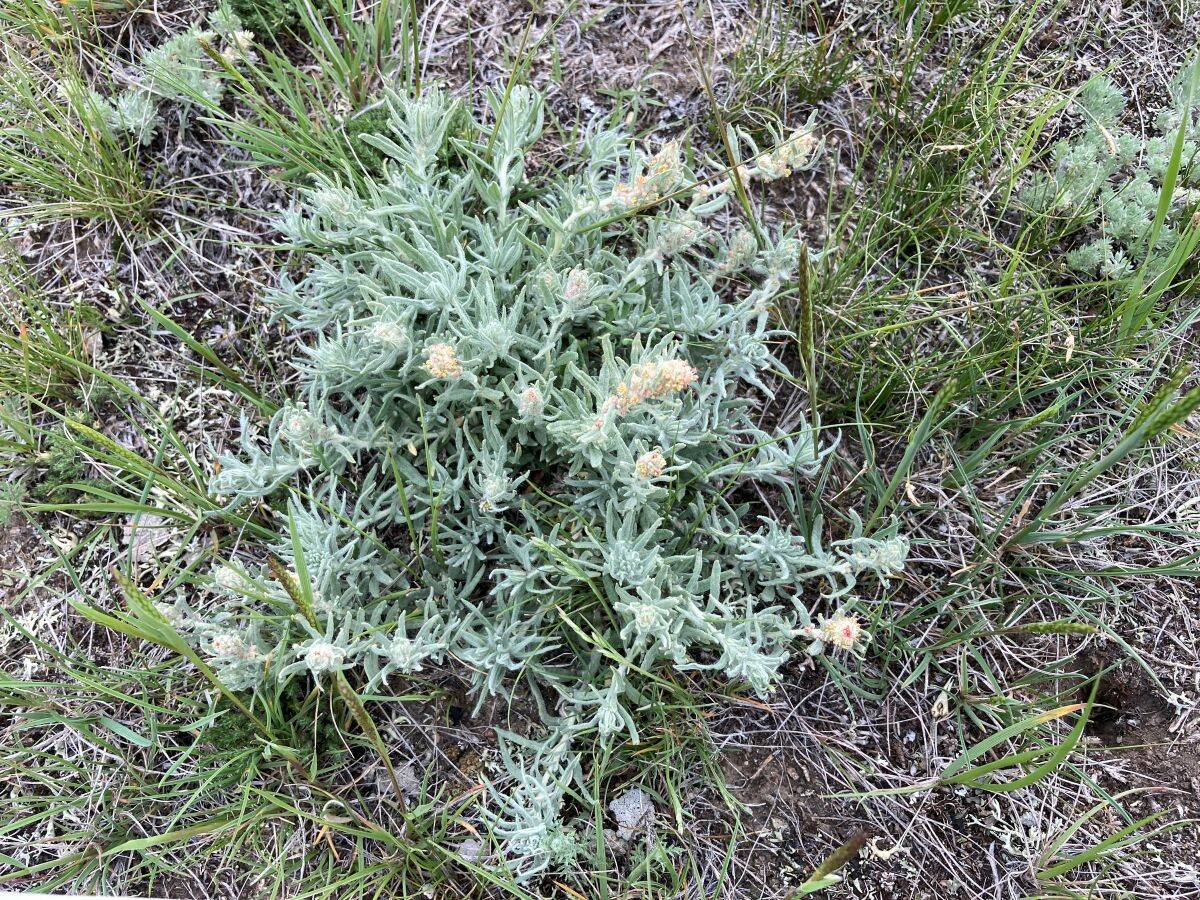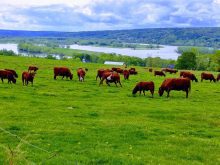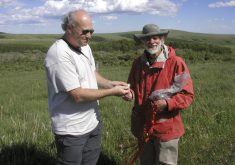Farmers and ranchers with well-established winterfat stands in their pasture are lucky to have it.
Krascheninnikovia lanata, more commonly known as winterfat, has been well known in the forage world for being palatable to cattle and resilient into the fall and winter months. It’s a native sub-shrub, with a woody base and herbaceous branches, according to the Saskatchewan Stock Growers Foundation website, and is also known as sweet sage, winter sage and lambstail.
Farmers and researchers have been interested in it for years, said François Teste, Agriculture and Agri-food Canada researcher.
Read Also

Considerations for salvaging crops for cattle feed
Salvage crops can be an option for feeding cattle, but there are a few considerations
“There’s a lot of data from previous research and stuff that shows it’s really good forage,” said Teste. “It’s great in the late season when there’s not much else available like it. It’s almost like a silver bullet in some respect.”
Mike Schellenberg did his PhD thesis, Comparison of production and nutritional value of two seed sources of winterfat, on the performance of winterfat on the Prairies, in 2005. The former research scientist with Agriculture and Agrifood Canada spent 35 years researching the beneficial plant before his retirement, and is still working as the science lead with the Saskatchewan Prairie Conservation Action Plan’s Living Labs project on native species restoration.
Winterfat is a species of interest, Schellenberg said, and is an ice cream plant — a preferred forage for cattle.
“It’s utilized not only by livestock, but by the wildlife as well. It provides a nice nutritional package for the animals, specifically in that fall/winter period. The crude protein tends to be a limiting factor in the fall/winter, whereas winterfat has a very high crude protein, higher than alfalfa even.”
Winterfat can be grazed well into the winter months, said Schellenberg, so it provides substantial supplemental benefits to ranchers, allowing them to save on feed costs in the winter. The initial research into winterfat also points to the chemical benefits of grazing it with other lower-quality forage, he said. Something in winterfat improves the cattle’s digestion and they get more out of what they’re eating.
Unfortunately, winterfat has often been mistaken for sage, leading many farmers over the decades to destroy entire winterfat stands. Sage isn’t harmful to cattle, but the smell reduces its palatability, making it less desirable in cattle pastures, said Teste. The Saskatchewan Stock Growers Foundation notes that winterfat lacks the strong smell of sage. Winterfat flowers are small and woolly, the foundation notes, resembling small cotton balls.
Teste said the plant does have its limits. The biggest risk, even to large winterfat stands, is cattle overgrazing. Given its palatability, Teste has seen small herds decimate entire winterfat patches.
“Around here at our sites, I was planning to collect some seed, and when I went back a week later, the little herd we have here just devoured all of it. I was like, ‘Oh my god, it looks like they killed it.’ No, they didn’t kill it, but it was pretty close.”
Seeding
If farmers and ranchers feel they are missing out on this “ice-cream plant,” planting winterfat on their pasture is not impossible, but different from throwing a kilo of seed in the seeder and going to town on a pasture, Teste said.
Seeds are not readily available in Canada and the United States, said Teste, although he does collaborate with researchers in Utah, who have a reliable seed source. There are some issues with storage as it doesn’t keep its vitality longer than one season, he added.
Winterfat does grow from New Mexico through the Midwest U.S. and up through Canada, all the way up to the Yukon, but different regions have different species, affecting their ability to overwinter, Schellenberg said.

“A lot of the material is not necessarily that well adapted to a Canadian environment, especially the more readily available germplasm that they have in the States.”
Initial research from Mitch Thacker, Matthew Madsen and their team at Brigham Young University saw an increase in flowability through mechanized seeders by using flash-flaming technology to remove the fluffy bracts of winterfat seeds. The four bracts protect the single seed and help the seed germinate and grow, they said, but the bracts also make it difficult for the seed to be handled in a conventional seeder.
Removing the bracts reduces the volume of the seed and allows a polymer seed coat to be added.
“We found that flash-flaming combined with seed coating improved the flowability of winterfat fruits, as measured with standard laboratory tests and by delivering fruits through a broadcast seeder and a rangeland drill,” noted the researchers in their paper, Use of Flash-Flaming Technology to Improve Seed Handling and Delivery of Winterfat (Krascheninnikovia lanata).
Teste has been playing around with the shrub-like forage plant for a few years now, testing how it can be planted in Saskatchewan pastures and the effect it has on the soil surrounding it. As the fluffy seeds don’t conform to conventional agricultural practices and machinery, Teste has been toying with best practices in widespread planting techniques for winterfat. He has hand-seeded them with great success.
Using fresh seed and no cleaning or sorting, Teste said his technique was simple; sow in the fall, then anchor the seeds so they don’t blow away, either by gently stomping them or lightly covering them with soil.
“We fall seeded, and we got a fairly decent winter with some snow. … They established too much. I might have to thin them — they’re too dense,” he said.
The Saskatchewan Stock Growers Foundation suggests broadcasting it in the fall or winter, as the freeze-thaw cycle can help it germinate. Seeding in the early spring can also work well if there’s enough moisture.
Matthew and Caleb Madsen at Wildland Seed Coating have been beneficial partners in Teste’s research in Canada, said Teste, as they work to discover more about this silver bullet shrub of the Prairies.
Soil effects
Everyone has some parcel of land that isn’t performing at its best, whether due to salinity issues or just a lack of yields, said Teste, and winterfat could be a good long-term option for pasture on those mixed operations. Education is a big part of getting more winterfat established back on the Prairies. Talking with producers, Teste said many recall their parents or grandparents talking about having winterfat in their pastures. Those people would be good candidates for getting acres re-established.
Being more shrub than grass-like, Teste said winterfat drastically changes the chemical and biological properties of the soil.
“It’s a little mini shrub, and has its own little microenvironment under its little mini canopy.” That includes many twigs and broken needles, he said, and more litter accumulation than some of the other native species.
Aside from the producer benefits, Teste said he is slowly but surely getting into researching winterfat’s potential to improve soil health. The little shrub is deeply rooted, so it is possible that it acts as a carbon sink and improves below-ground biodiversity in the soil, he said. But research into the soil benefits of winterfat is in its initial stages.
Winterfat grows in the same spots as the parent plants, another fact that interests Teste. That doesn’t always happen in the plant world, he said.
“Most of the species here, the seeds are flying all over the place. They like to land in a disturbed (area) or an area where their own parents or species are not growing. They tend to prefer that. But (with) winterfat, that doesn’t seem to be the case.”
Some plant stands are over 100 years old, and Teste would love to take samples of these stands to test for carbon and soil diversity, but he hasn’t had time yet through the Living Labs project, he said. As a potential carbon sink, “that little shrub is probably a good bet, because it does get pretty woody and has deep roots.”















